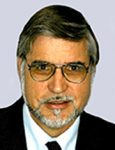 Dr. Shakal has been associated with the California Geological Survey’s Strong Motion Instrumentation Program (SMIP) for the past 32 years, and has successfully grown and led the Program for the past 27 years.
Dr. Shakal has been associated with the California Geological Survey’s Strong Motion Instrumentation Program (SMIP) for the past 32 years, and has successfully grown and led the Program for the past 27 years.
Under Dr. Shakal’s direct supervision and innovative management, the SMIP operates the largest and most advanced strong–motion network in the United States. The SMIP also is the largest strong–motion component in the U. S. Geological Survey’s Advanced National Seismic System. In 2006 at the commemoration of the Great 1906 San Francisco Earthquake, the SMIP received the Applied Technology Council/Engineering News Record joint award as the Best Seismic Program of the Twentieth Century.
To date, Tony’s SMIP group has installed over 5,000 accelerometers at nearly 1,200 stations around the State. These seismic monitors have been placed in over 850 free-field ground stations, and in more than 80 bridges and 200 buildings. Ground motion and structural response data gathered from this network are directly employed in the California Building Code to make structures more earthquake resilient. Two very recent examples of Tony’s diverse skills can be seen in the successful completions of the Rincon One Tower, and the new Oakland Bay Bridge just being completed.
The Rincon One Tower building is 64 stories in height and sits atop the Rincon Hill at the edge of San Francisco Bay. It is the most densely instrumented high-rise residential building in the United States, and perhaps in the world. Tony’s great skills became clear when, after three years of detailed preparation with the Building’s owners to install seismic CGS monitoring equipment, the USGS asked to join in with a new instrumentation layout and process. Tony delicately re-negotiated new terms with the Building’s owners, and in a cooperative effort between the CGS/SMIP and the USGS, successfully completed the project with no hitches, on time, on budget, and without disturbing any of the tenants. This unique structurally designed building has real-time seismic monitoring on nearly every floor.
Scheduled to open the first week in September 2013 is the $6.5 Billion Oakland Bay Bridge, with its structurally unique, slim flyover design and self-anchored cable suspension signature section. Under Tony’s personal oversight, 220 seismic instruments have been installed. Because of the Bridge’s unique design, and constant structural changes and construction problems, the task for the SMIP crews has been exceptionally intense. Tony’s diplomatic skills and his well-respected professional and technical engineering abilities enabled SMIP to install instruments from the base of the Bridge’s footings deep under the Bay’s seabed, to the top of the Signature Section mast several hundred feet above the roadbed. Even the suspension cables have sensors to monitor the Bridge’s unique structural design responses.
Dr. Shakal continues to expand and promote the educational and communication links between the Structural Engineering and Seismological communities through financially supporting an annual conference in which SMIP-sponsored research papers are presented (this year, SMIP ’13 is in Los Angeles). He participates as an active member of the standards setting Consortium of Organizations for Strong Motion Observation Systems (COSMOS), and works closely with the California Department of Transportation (Caltrans), and the Office of Statewide Health Planning and Development related to earthquake engineering for hospitals. Tony, also, finds time to write technical research papers to help publicize the latest findings from the programs he oversees.
Dr. Shakal received his award at the 2014 COSMOS conference.
